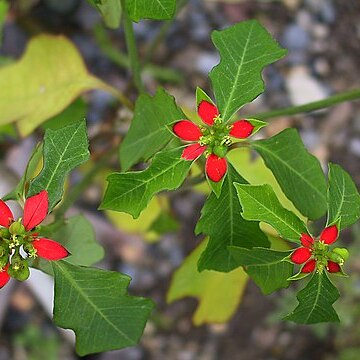Erect shrubby annual herb to 1 m. high, with glabrous stems and branches.. Leaves ovate to markedly panduriform, to 10 × 5 cm., base cuneate, apex obtuse, margin shallowly toothed, upper surface glabrous, lower surface pilose with curved septate hairs, glabrescent; petiole to 1.5 cm. long, pilose; glandular stipules brownish.. Cyathia densely clustered in terminal cymes, forking ± 4 times, with progressively shorter rays from ± 5 cm. to 2 mm. long; basal bracts similar to the leaves with a bright red blotch at the base, the upper ones progressively smaller, more lanceolate, sub-sessile and entirely red.. Cyathia glabrous, ± 3.5 × 3 mm., with barrel-shaped involucres; gland peltate, funnel-shaped, 1.5 mm. long, the opening transversely elliptical, 2 mm. wide; involucral lobes rounded, 1.5 × 1.5 mm., margin deeply lobed.. Male flowers: bracteoles ligulate, apices feathery; stamens 4 mm. long.. Female flower: ovary pedicellate, glabrous; styles 2 mm. long, bifid almost to the base.. Capsule exserted on a reflexed pedicel to 5.5 mm. long, deeply 3-lobed, 4 × 5 mm.. Seeds ovoid-conical, with acute apex, 2.8 × 2.2 mm., blackish brown, surface sharply tuberculate.
Herbs, annual, shrubby, erect to 1 m tall. Stems glabrous, hollow. Leaves alternate; stipules brownish glands; petiole to 1.5 cm, pilose; leaf blade lanceolate in outline, violin-shaped, to 10 × 5 cm, abaxially sparsely pilose, glabrescent, adaxially glabrous, base cuneate, margin shallowly and irregularly toothed, apex obtuse. Inflorescence a terminal cyme forking ca. 4 times, cyathia densely clustered; basal bracts similar to leaves but with a bright orange-red blotch at base, upper bracts progressively smaller, more lanceolate, subsessile, entirely red. Cyathia ca. 3.5 × 3 mm; involucre barrel-shaped, glabrous, lobes ca. 1.5 × 1.5 mm, rounded, margin deeply and bluntly toothed; glands 1(or 2), funnel-shaped, opening transversely elliptic, ca. 2 mm wide. Male flowers: bracteoles ligulate, feathery; stamens ca. 4 mm. Female flower: ovary pedicellate, glabrous; styles ca. 2 mm, bifid almost to base. Fruiting pedicel reflexed to 5.5 mm; capsule deeply 3-lobed, ca. 4 × 5 mm. Seeds ovoid-conical, ca. 2.8 × 2.2 mm, apex acute; seed coat sharply warty, blackish brown. Fl. and fr. May-Nov. 2n = ?56.
Erect annual, to 1 m, usually branched, glabrous or nearly so (or the lvs seldom sparsely pilose beneath); lvs mainly or all alternate (or the uppermost opposite), variable, even on the same plant, from linear to broadly oblong or ovate or pandurate, entire or serrate to lobed, the upper mostly lobed and blotched with red or white at base; involucral gland solitary, bilabiate, cupulate, usually wider than high; fr smooth, 6–8 mm thick; seeds tuberculate, 3–3.5 mm, without a caruncle; 2n=28, 56. Moist soil, often in shade; trop. Amer. and s. U.S., cult. and escaped n. to Va., Wis., and Minn. Summer. (E. heterophylla and Poinsettia h., misapplied; Poinsettia c.)
Leaves with a petiole to 1.5 cm long, pilose; stipules modified as brownish glands; lamina to 10 × 5 cm, markedly panduriform, obtuse at the apex, cuneate at the base, shallowly and irregularly toothed at the margin, glabrous on upper surface, sparsely pilose with septate hairs on lower surface, glabrescent.
Cyathia c. 3.5 × 3 mm with barrel-shaped involucres, glabrous; gland peltate, 1.5 mm long, funnel-shaped, the opening transversely elliptic, 2 mm wide; lobes 1.5 × 1.5 mm, rounded, margin deeply and bluntly toothed.
Annual herb, up to 1 m high. Leaves ovate to linear or sometimes fiddle-shaped, entire or toothed, upper leaves and bracts red or red-based. Floral bracts pan-duriform, with red blotch at base. Flowers green.
Annual herb, up to 500 mm tall, pilose with long spreading hairs. Leaves reflexed, linear-lanceolate to ovate, subentire to markedly serrate. Styles erect, up to 2.5 mm long. Flowers reddish brown.
Basal bracts similar to the leaves but with a bright orange-red blotch at the base, the upper bracts progressively smaller, more lanceolate, subsessile and entirely red.
Cymes terminal, each forking c. 4 times, with rays progressively shorter from 5 cm to 2 mm long and cyathia densely clustered.
Seeds 2.8 × 2.2 mm, ovoid-conical with acute apex and warts sharply pointed, blackish-brown.
Female flower: ovary pedicellate, glabrous; styles 2 mm long, bifid almost to the base.
Capsule exserted on a reflexed pedicel to 5.5 mm long, 4 × 5 mm, deeply 3-lobed.
Shrubby annual herb, erect to 1 m high, with hollow glabrous stems and branches.
Male flowers: bracteoles ligulate, feathery; stamens 4 mm long.

